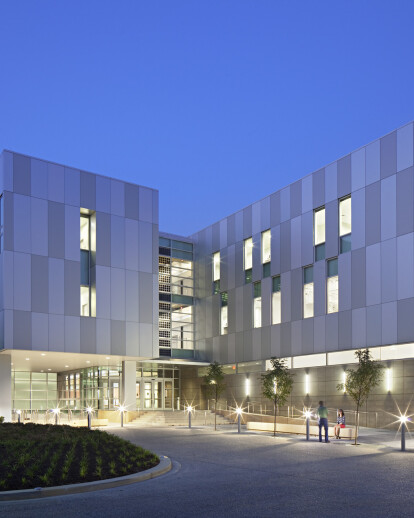The Center for the Built Environment and Infrastructure Studies (CBEIS) is conceived as an exchange of people, ideas, departments, and building technologies. Housing multiple design and engineering disciplines under one roof, CBEIS promotes interactivity among constituent students and faculty from the Institute of Architecture and Planning, Department of Civil Engineering and Institute of Transportation. As a gateway site on the campus periphery, CBEIS also mediates between the developed edge of Perring Parkway on one side and the bucolic natural setting of Herring Run on the other.
Multiple departments are accommodated on the four levels of the building. In the spirit of collaborative engagement, two slender "bars" bound a sky-lit atrium that runs the length of the building to create an internal street where programs mix, student vitality is expressed, and social spaces meet learning environments. The “street” features a café, lounges, information kiosk, departmental “store fronts”, visual connections to academic studio spaces, and a flexible gallery space. At the ground level, the atrium is visually permeable revealing the creative studio activities to all who enter or pass through. Stretching beyond the confines of the building, the "street" extends to connect to the new parking deck, bus drop-off, and aligns with the primary interior circulation of the neighboring Mitchell and Schaeffer engineering building -- reinforcing a strong connection to other engineering disciplines at Morgan State University.
The exterior design reflects the varying site conditions. The fenestration is more fragmented and energized along the busy Perring Parkway where the major communal spaces of the library and conference center are expressed through bold arrays of vertical solar louvers. Along the quite, natural setting of Herring Run, the building is calm with expanses of continuous fenestration, unbroken horizontal shading, and features multiple outdoor terraces for informal students and faculty engagement.
CBEIS also serves as a laboratory for sustainability in design and engineering. To this end, the project is targeting LEED Gold certification. Not only are day-lighting strategies, resource conservation and energy efficiency measures leveraged to meet sustainability goals, multiple systems to achieving each of these ends are deployed to visually reveal the engineering options and serve as pedagogical reference points. Five types of daylight harvesting are used, two green roof systems are deployed, and traditional rooftop photo voltaic (PV) panels are combined with curtain wall integrated PV collectors to illustrate the various technologies available. The building also features a gray water system, solar hot water, natural ventilation, and an intricate landscape that threads through the site to demonstrate the capture, containment, and filtering of stormwater.
Sustainable technologies are deliberately revealed to build awareness, support teaching, and ultimately foster more environmentally responsible citizens. To illustrate the dynamic and integrated nature of the building systems, atrium displays graphically monitor building performance relative to weather variance and building use fluctuation. These displays not only capture current performance, but also graphically track it against historic use to reflect trends.
Though seemingly simple in plan, the CBEIS design is carefully detailed to mediate between urban and natural environments, city and campus contexts, and human interaction with building technologies. Most importantly, CBEIS is a dynamic forum for social engagement and intellectual exchange.






























